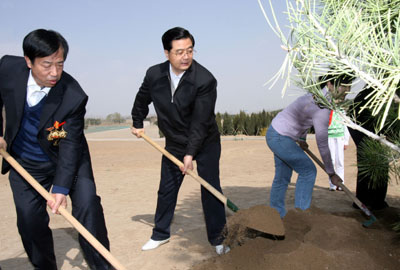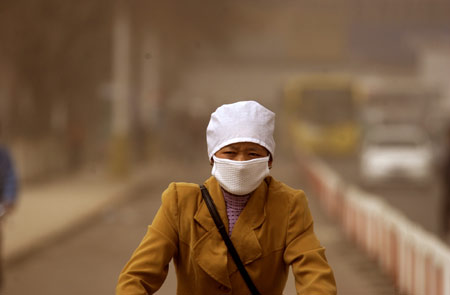North China brace for sandstorms
By Xie Chuanjiao (China Daily)Updated: 2007-04-02 06:45
Many parts of northern and northwestern China were bracing for two more days of sandstorms as senior leaders, including President Hu Jintao and Premier Wen Jiabao, joined 2 million people to plant saplings in Beijing yesterday to combat the change in climate.
The China Meteorological Administration (CMA) has forecast severe sandstorms in Nanjiang Basin of the Xinjiang Uygur Autonomous Region and western parts of Gansu Province over the next two days. Beijing, however, will not be hit by any of the storms.
| |||
Sandstorms originating in Xinjiang and Inner Mongolia because of deforestation and degradation of land have hit Beijing and some coastal regions every spring for a number of years.
The CMA said the year's ninth sandstorm disrupted life and traffic in Inner Mongolia, northern Shaanxi, southern parts of North China and Shandong since 8 am yesterday.
The CMA has forecast Force 7-8 winds (with 12 being the strongest) in most of the above areas, too.
"The storm has been caused by a strong cold air front moving south," CMA senior engineer Sun Jun said. "The cold air front will cause the mercury to drop by 4-14 C in Central and South China, including Sichuan, Guizhou and Hubei.
Sandstorms hit parts of Inner Mongolia and Ningxia, Gansu, Shaanxi, Xinjiang and Liaoning on Friday.
President Hu and Premier Wen planted trees at the Olympic Forest Park yesterday, the 23rd tree-planting day for Beijing.
|
|
China started a green movement after floods claimed more than 1,000 lives and rendered a million people homeless in Sichuan Province in 1981. Every person above the age of 11, except the old and the disadvantaged, is required to plant three to five saplings per year to sustain the country's ecology.
But unfortunately, only 55 percent of the targeted population planted trees last year, according to State Forestry Administration (SFA) data. In actual numbers, the SFA said, about 550 million Chinese planted 2.16 billion trees in 2006.
China's forest area reached 175 million hectares last year. Though the forest cover has increased from 12 percent in 1981 to 18.21 percent today, it is still less than two-thirds of the world average.
|
||
|
||
|
|



